Possibility As Reality
19 July to 9 August 2025

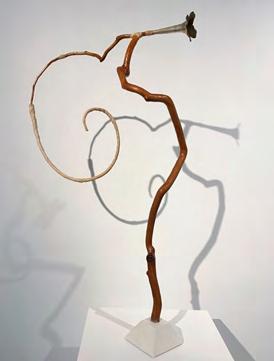


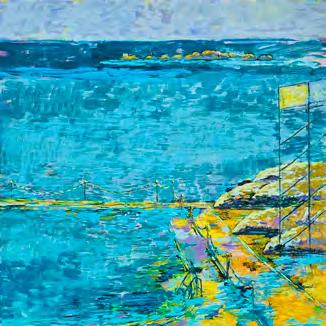
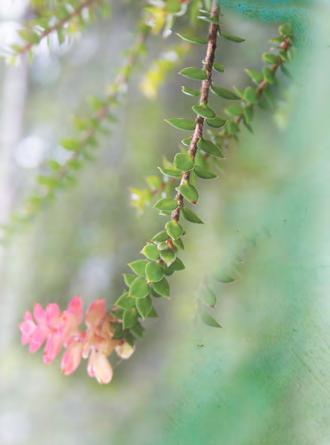








All works and text © the artists, Maggie MacKellar and GCS Gallery, No material, whether written or photographic, may be reproduced without prior permission.

19 July to 9 August 2025














All works and text © the artists, Maggie MacKellar and GCS Gallery, No material, whether written or photographic, may be reproduced without prior permission.
July to 9 August 2025
The Grace Cossington Gallery is delighted to present Possibility as Reality to celebrate Abbotsleigh’s 140th birthday. The exhibition, curated by Rhonda Davis, Head Curator, Macquarie University Art Gallery, brings together 14 Abbotsleigh Old Girl artists whose work reflects the richness and evolution of contemporary art practice.
The artists represent each decade from the 1960s to the 2010s, showcasing a wide range of approaches and mediums that speak to both personal and collective experience. The exhibition offers a compelling intergenerational dialogue that celebrates the creative legacy of Abbotsleigh and its contribution to the broader cultural landscape.
We offer thanks to:
The exhibiting artists:
Lucy Barker (1992)
Lucy Buttenshaw (1979)
Jaq Davies (1980)
Rachel Fairfax (1990)
Louise Fowler-Smith (1973)
Emily Galicek (2012)
Janet Laurence (1963)
Fiona Mitchell (1975)
Lisa Pang (1985)
Eloise Rankine (2010)
Helen Redmond (Bondfield, 1973)
Julia Roberts (1983)
Alex Snellgrove (1976)
Sally Stokes (1970)
Maggie MacKellar (1990) for her inspiring introduction
Cathy Wilcox (1980) for opening the exhibition
Rhonda Davis for curating the exhibition
Commission from the sale of artworks will benefit the Kathleen McCredie Award.
Mary Oliver, the great poet and disciple of attention, wrote ‘the world’s otherness is an antidote to confusion, that standing within this otherness – the beauty and the mystery of the world, out in the fields or deep inside books – can re-dignify the worst-stung heart.’ I read this in Oliver’s essay Staying Alive at the same time as I was studying the works for the exhibition Possibility as Reality. This exhibition is a celebration across intergenerational artists who share a foundation in the art rooms of Abbotsleigh. Oliver’s idea, that if we can stand within otherness, in books or in nature, then we can find an antidote for confusion and a moment of healing, seems to apply just as much to works of art as to books or nature.
As a writer, I’ve always been a little envious of the accoutrements of the artist’s studio. It’s the physicality of art that I’m jealous of, the way you need to use your body to make something, to take an idea and give it a physical form. Take the sculpture, Quiver (Jaq Davies), which exists as both object and shadow and, for me, it seems to celebrate the sacredness of making a mark, the commitment of creating and following a line. Then there is the work of Rachel Fairfax, my fellow 1990 classmate. Her paintings of Coogee are a study in blue. When I look at those paintings, I’m in the pool, I’m in the sea, the lap and slap of it, viewing them is like receiving the benediction of salt water. Julia Roberts’ work is also immersive but she paints trees. Trees like snakes, trees like the milky way, trees like raindrops and maps, trees like totem poles. Whole forests of them filled with movement and colour. From movement I turn to stillness. Janet Laurence’s work, Fallen from a Fragile Forest Floor, holds a moment of quiet that pulls out of my world of barking dogs and tractors and into the timelessness of the forest. Helen Redmond’s pursuit of light and silence through glazed oils is so different in process and subject to Laurence, but she too gifted me silence, capturing light and time in her glazes. I come to the work of Louise Fowler-Smith and her devastating forest scene. Pick up the pieces of the puzzle. Participate she says. Witness what our voracious appetite for resources is destroying.
Eloise Rankine is using a different sort of fragility in the vessels she throws on her potter’s wheel. Working with patterns and textures drawn from her domestic world, she shapes vessels that gesture to the disruption of reality. She carves into these vessels, so they become a canvas for her drawing. Lisa Pang’s cotton and silk hand dyed sakiori weaving, on backstrap looms with domestic utensils, are mostly created in one place with the memory of another place in mind. Look closely and find flashes of pink, yellow, sun
dapple spots, a hint of the Sakura (cherry blossom) in her representation of spring. Winter is a day of mountain mist and descending fog, bare brown branches holding water drops, pale bark and the dark splice of evergreens. And summer, the corner of a red oxide roof jostling with verdant greenery, red urushi bowls, heat haze. All these stories told in a length of cloth.
Emily Galicek is working backwards in this digital age. She is taking historically overlooked decorative elements from wallpapers, from tiles, from upholsteries, those soft furnishings that are not considered ‘art’ and translating them from patterns to paint. Her work upends our expectation of what is art. And then there is the glorious playful interactive mystery of Lucy Barker’s glomesh sculptures. I have such a strong memory of my grandmother’s handbag, the luxury of it, faint scent of cigarette, hint of gossip, the bustle of a party. And here it is, in Barker’s interpretation, a portal to my childhood. Nostalgia too in Fiona Mitchell’s work. The nasturtiums, that companion plant, the light on the teapot, the kitchen table, the tableau of domesticity, made beautiful in its simplicity. Have you ever seen a brolga dance? If not, go and stand in front of Lucy Buttenshaw’s painting of a brolga and a woman and ask what this fable might tell you. And from here perhaps pick your way to Alex Snellgrove’s work. The beach, the beach. Stand in front of this painting and feel the lick of waves on your toes, the heat of the day leaching up through the sand, the salt on your skin, tightening it. And then step into Sally Stokes’ Sitting alone. It’s a kaleidoscope. Her use of pattern and colour evokes the angophora forest, the sandstone cliffs, the hint of water through the trees. It’s a place I know but cannot name, and I find joy rising because she’s caught something I can’t put into words, but if I stand in the space she’s made, I feel a sense of place that is outside my clumsy tools.
Each of these works offers a moment of connection, a moment where we can stand within the world’s otherness. The artists, working in different disciplines, from different decades, all speak about the transformative quality of the Abbotsleigh art room. Here, their practice was taken seriously, and they began the journey of interpreting our world. From childhoods on sheep stations, on the coast, in the forests, in suburbia, they have taken the possibilities of vision, imagination and worked with materials to create a reality in which we, the needy, might stand in front of and be saved.
Maggie MacKellar July 2025
Lucy Barker explores the transformative potential of art as a catalyst for cultural connection and change. With a background in digital design and visual communication, her work sits at the intersection of the digital and physical, often inviting audiences into playful, interactive experiences that challenge traditional boundaries of artmaking.
Barker’s particular interest and true passion lie in interactive public art and her process is intuitive and emotionally driven – an evolving dialogue between material, memory and meaning.
Her studio, a quiet haven filled with half-formed ideas and decades of sketchbooks, reflects her belief in art as both a personal sanctuary and a communal bridge. Barker’s installations often emerge from a deep concern for the environment and a desire to work sustainably, using familiar materials in unexpected ways to spark curiosity and reflection.
For the works in this exhibition Barker was inspired by the iconic Australian fashion brand, Glomesh, first designed and manufactured in Bondi in the late 1950s. With the help of Capral and Artforms, she has modelled blankets on an upscale version of Glomesh and pushed the creative boundaries of aluminium.
Playfulness and accessibility are hallmarks of her work, which has been exhibited widely, including at Sculpture by the Sea (2025 will be her fifteenth time) and in collections around the world. Whether through a public sculpture or a spontaneous drawing, Barker’s art invites us to pause, engage and reimagine our relationship with the world and each other.
https://www.lucybarker.com.au/about


top: Glittering Prize, 2024, powder-coated aluminium, fibreglass and polyester resin 1.8 x 1.6 x 0.8 m
below: Lost and Found, 2025, timber, ceramic and brass
19 x 14 x 5 cm
Lucy Buttenshaw is inspired by the quiet magic of the everyday. Raised on a remote farm in regional New South Wales, her work is shaped by the rhythms of rural life – its solitude, creatures and vast, open spaces. Now based near West Wyalong, she continues to draw inspiration from the familiar: fleeting encounters, anecdotal memories and the subtle connections between people, animals and place.
Buttenshaw’s art is deeply observational, yet never static. It invites viewers into a world where small moments carry weight and meaning, where the personal becomes universal and gives form to the bigger questions about how we interact in our world.
Her paintings begin with a story – sometimes imagined, sometimes remembered – that evolves through drawing and layered markmaking. Working in both acrylic and oil, Buttenshaw treats painting as a conversation, allowing the narrative to emerge through process. Her studio, a repurposed weatherboard schoolhouse nestled near a woolshed, offers the serenity and space that echo through her work. Alongside her studio practice, Buttenshaw teaches Art, English and piano playing and is involved in community art projects.
www.lucybuttenshaw.com
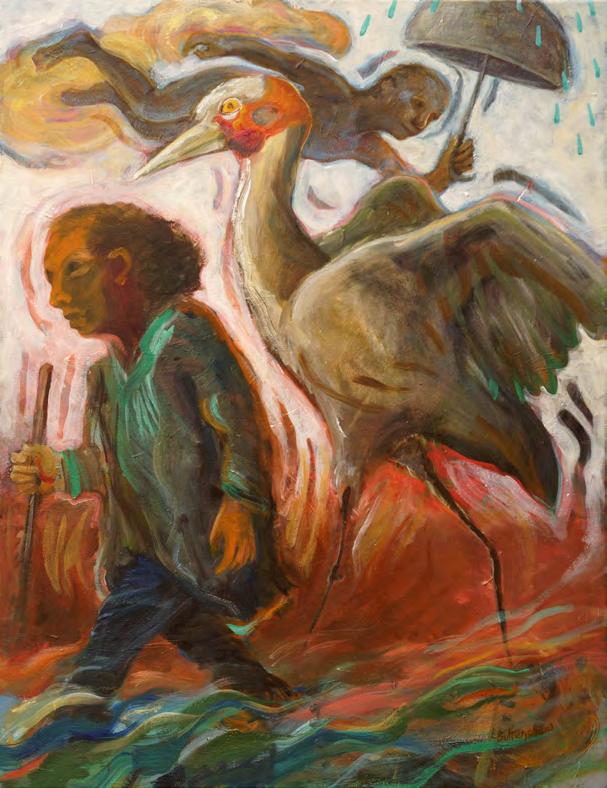
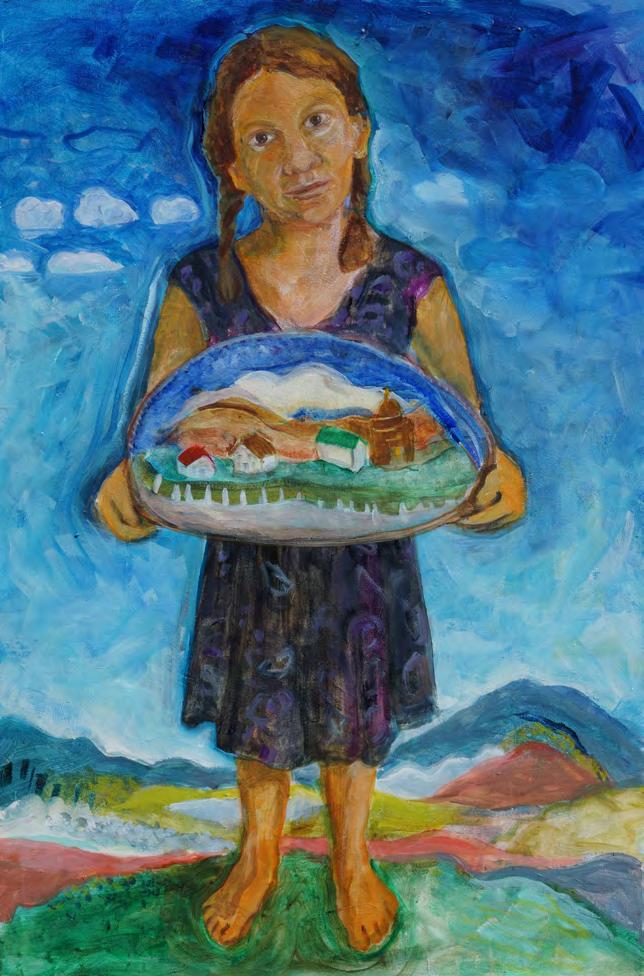
Jaq Davies is an artist whose practice is deeply rooted in the landscapes and textures of the Central West of NSW, where she lives and works. Her work, a quiet meditation on memory and material, is informed by personal experiences and often deals with time and the way that life and art become so perfectly intertwined.
As a multidisciplinary artist, Davies often blurs the boundaries between drawing and sculpture, extending the line into three dimensions using found objects, feathers, wire, hair, thorns and glass, transforming the everyday into poetic gestures. The interchangeability between mark making and sculpture allows her to explore further these tensions between 3D objects and the drawn line, creating a place of constant play and exploration. Her creative process is one of intuitive exploration, where objects become marks and marks become stories. These narratives, drawn from personal experience and an inner world, are layered with a sense of history. Her studio, nestled at the end of a long boomerang-shaped house and visited by two unruly ponies, is a space of joyful chaos and creative freedom.
Davies’ early artistic life was shaped by afternoons on the banks of the Darling/Barka River, watching her father paint. These formative moments instilled in her a belief that creativity is essential to life. Today, her work continues that legacy – inviting viewers to pause, reflect and find meaning in the quiet interplay between material, memory and place. Davies is a finalist in the Dobell Drawing Prize 2025.


Rachel Fairfax draws inspiration from nature, whether it is the landscape or the creatures that inhabit it, and her practice spans drawing, painting and ceramics. Her work begins with drawing, often on location, capturing the essence of seascapes, birds and animals from her childhood home of Tuncurry-Forster and her current surroundings in Coogee.
These drawings evolve into expressive, abstracted paintings that move beyond representation, becoming meditations on colour, gesture and the act of painting itself.
Fairfax’s creative process is intuitive and layered, grounded in observation but driven by emotion and material exploration. Her studio, a light-filled space at home, is both a sanctuary and a shared environment, where the sounds of her son building with LEGO accompany her own acts of making. This balance of domestic life and artistic practice reflects the fluidity and richness of her work.
Her work has been exhibited widely and is held in both public and private collections across Australia. Fairfax is represented by Stella Downer Fine Art in Sydney and Harvison Gallery in Perth, and continues to develop a thoughtful, evolving practice that invites quiet reflection and connection.

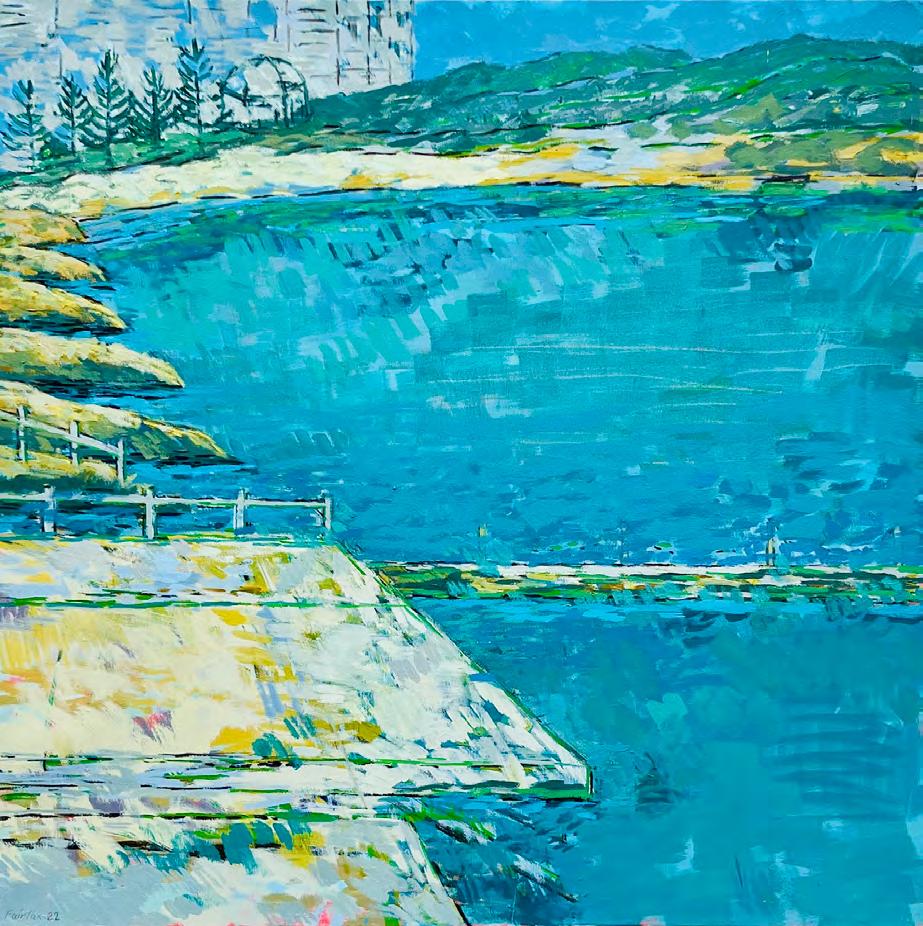
Louise Fowler-Smith is an environmental artist whose multidisciplinary practice spans painting, photography, sculpture, video and textiles. Originally trained as a painter, and prior to the availability of computers and digital media, she screen-printed photographic imagery onto a variety of surfaces, including plastics and metal, and then incorporated these into her paintings. For over 30 years, she has explored the relationship between art, nature and spirituality, creating work that honours the land and raises awareness of environmental issues. Her creative journey began in the tranquil landscapes of her father’s farm near the Barrington Tops, where the presence of trees and rivers instilled a deep sense of reverence for the natural world.
Fowler-Smith’s process begins with an idea, often rooted in ecological concern or spiritual symbolism, and evolves through the careful selection of materials that best express the message and emotion of the work, and art acts as a form of advocacy and connection. She is the founder of the Tree Veneration Society Inc., which raises awareness about the natural environment through exhibitions, symposiums, workshops and performances, and her research has led to the publication of Sacred Trees of India.
Exhibiting nationally and internationally, Fowler-Smith continues to memorialise endangered and extinct plant life, creating art that is both a tribute and a call to action.
louisefowlersmith.com



Takayna Old Growth/Takayna Wood Chip, 2024, full colour, high resolution digital print on white permanent self-adhesive vinyl and on Colorbond, magnets, wood, 100 x 40 cm
This artwork enables an interactive component with ‘jigsaw’ like pieces. Peel away the segments of Takayna Old Growth to reveal what remains of the forest once the trees have been felled.
Emily Galicek explores the intersection of digital processes and contemporary painting. Her works begin as digital collages, constructed from fragments of historical imagery, which are then translated by hand onto canvas. This act of translation, with all its imperfections, becomes a metaphor for the fluidity of memory and the shifting nature of history. Galicek’s current research focuses on the decorative, specifically elements of historical domestic interiors. Often dismissed as ornamental or peripheral, she repositions these motifs as rich socio-cultural documents, reactivating them through experimental painting. Her process is deeply rooted in archival research, drawing from museum collections and image libraries to create layered compositions that are both playful and reflective. A particular inspiration is the rolls of wallpaper that had been stored for almost 50 years in the home of her grandmother.
Working from a light-filled studio in Marrickville, Sydney, Galicek surrounds herself with books, visual references and the quiet hum of historical podcasts. Her studio is a space of clarity and curiosity, where digital and analogue methods converge.
In 2024, she was awarded the Eva Breuer Travelling Scholarship by the Art Gallery of NSW and completed a residency at the Cité Internationale des Arts in Paris. Galicek continues to develop a practice that is both visually rich and conceptually rigorous, inviting viewers to reconsider the overlooked details of the past.
www.emilygalicek.net


Janet Laurence is profoundly aware of the interconnection of all living things – animal, plant, mineral – and the fragile ecosystems they inhabit. Working across painting, sculpture, installation, photography and video, Laurence creates immersive environments that explore the emotional and ethical dimensions of our relationship with nature. Her work invites viewers to look not at the landscape but into it – beyond the surface, into its memory, vulnerability and potential for healing.
Laurence’s materials are as layered and complex as her themes: ash, minerals, oxides, living plants, corals, taxidermy and glass are combined in poetic assemblages that speak to the delicate dependencies within our environment. Her installations often extend beyond the gallery, transforming public spaces into contemplative encounters with the natural world.
Her practice sits at the intersection of art and science, drawing on research, collaboration, and a deep sense of care. Through her work, Laurence addresses the urgent realities of climate change and ecological loss, while also offering a space for reflection, empathy and connection.
Laurence has exhibited widely in Australia and internationally. She has received notable grants and fellowships, most recently, she was the 2021 Recipient of the Antarctic Fellowship and was represented in the Biocenosis 21 exhibition by the IUCN Congress for Biodiversity, Marseilles, France. Her work is held in major public, private and institutional collections. Her practice continues to evolve as a vital and poetic response to the environmental challenges of our time.
Janet Laurence is represented by Cassandra Bird Sydney; Arc One Melbourne and Hugo Mitchell Adelaide
www.janetlaurence.com

Fallen from a Fragile Forest Floor, 2021-2024
120 x 80 cm
Fiona Mitchell is an artist whose painting practice is grounded in a deep appreciation for light, form and the expressive potential of colour. Trained in architecture, she studied drawing, painting and art history alongside her design education – experiences that continue to inform her approach to still life and portraiture. A formative influence was her lecturer, Lloyd Rees, whose reverence for light and landscape left a lasting impression.
Mitchell’s paintings, often rendered in acrylic on canvas or board, explore the subtle shifts in mood created by light falling across a face or an object. Her process is intuitive and tactile – she delights in the freedom of pushing colour across a surface, capturing fleeting expressions or the quiet presence of everyday objects. Painting from life is central to her practice, offering a space for connection between artist and sitter, and the challenge of conveying both likeness and personality.
Her most cherished studio space has been the open verandah of her family home, where the sounds of birdsong and the kettle boiling became part of the creative rhythm. In both architecture and painting, Mitchell seeks to shape space and emotion, inviting viewers into moments of stillness, intimacy and quiet observation.
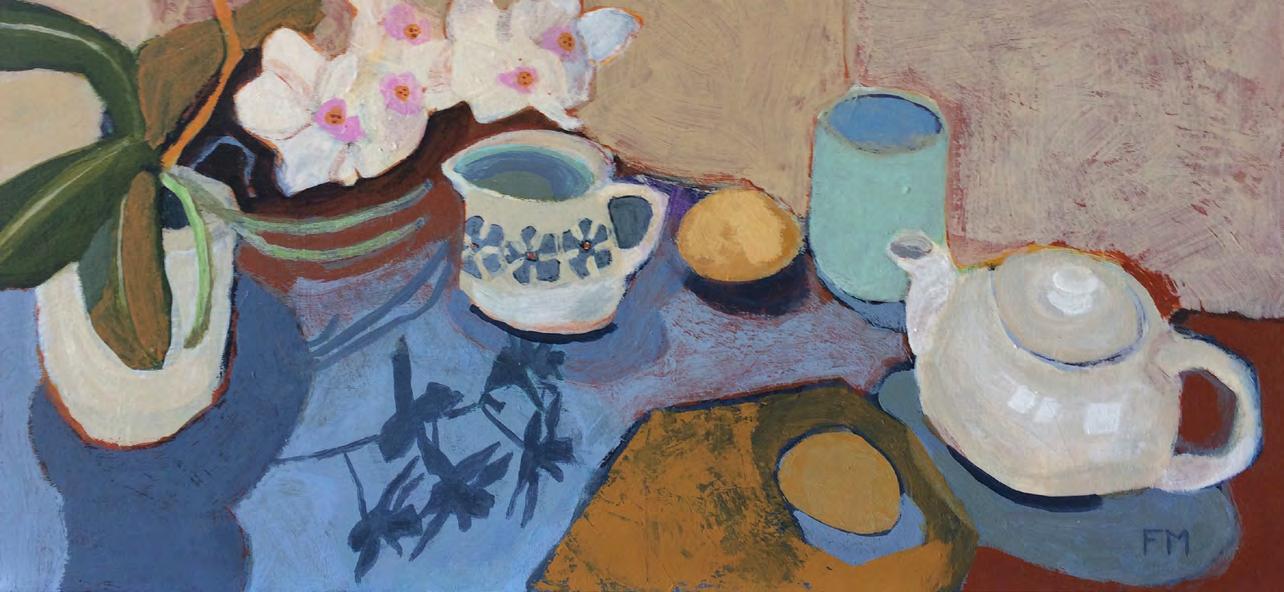

Lisa Pang is a Borneo-born artist, writer and curator with a particular interest in non-objective art, handmade textiles and alternative art platforms. Working across painting, textiles and assemblage, Pang draws on the histories embedded in salvaged and domestic materials – fabrics, paper and remnants marked by time – to create works that hover between painting and sculpture, art and craft.
Her practice explores the quiet power of materials, and her process is slow and intuitive, led by the character of each material and the traces it carries. Stitching, layering and assembling become acts of care and inquiry, revealing how the overlooked or everyday can hold complex cultural and emotional weight. Pang’s interest in the decorative and the domestic is not nostalgic but critical, reframing these elements as sites of meaning, memory, and resistance.
Her home studio, filled with filtered northern light, is a space of quiet rhythm, where jazz and true crime podcasts mingle with the soft presence of her dog. With a background in law, a BFA (Hons) from the National Art School and exhibitions in Australia, Japan and Europe, Pang brings a thoughtful, research-driven approach to her work. Pang’s practice is a meditation on ambiguity that enables a narration about how we might perceive and value work and artwork in contemporary life.
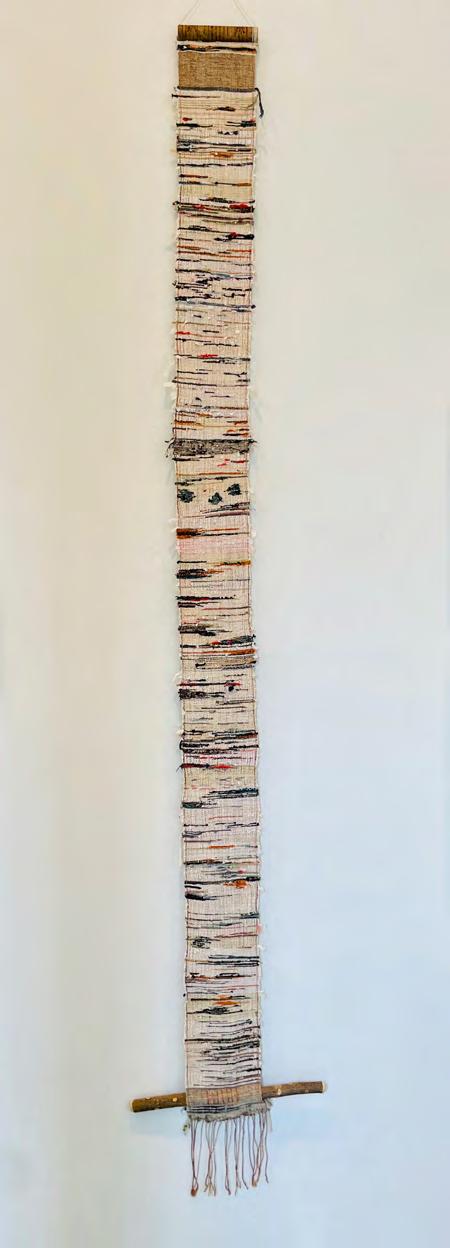

left, Summertime (Natsu), 2023-2024, cotton and silk sakiori weaving with domestic utensil, 200 x 15 x 3 cm
right, Wintertime (Fuyu), 2023-2024, cotton and silk sakiori weaving with domestic utensil, 210 x 15 x 2.5 cm
Eloise Rankine explores the tactile and expressive potential of clay, drawing on the textures and patterns of domestic life, particularly those found in traditionally feminine crafts of quilting and embroidery. Her ceramic forms are predominantly thrown on the pottery wheel using porcelain, and forms then evolve through carving, altering and glazing, creating surfaces rich with repeated marks and quiet detail.
Rankine works between ceramics, installation and drawing. Drawing remains central to her process, now expressed through surface and form rather than paper. Often Rankine’s ceramic work embraces imperfection. By combining refined forms with broken or altered pieces, she reflects on the fragility of ceramics and her learning that the mastery of ceramics comes through failure.
Rankine has exhibited at the Sydney Opera House as a finalist in the Uncovered program (2022), at the Sydney Contemporary Art Fair with Utopia Art Sydney (2015-2019), and in regional galleries across NSW, Victoria, and Queensland. Her work has also been recognised in national drawing prizes, including the Dobell Prize for Drawing (AGNSW, 2011).
Working from a converted shed in the Southern Highlands, Rankine creates in a peaceful, light-filled studio surrounded by nature. Her work invites reflection on repetition, resilience and the quiet strength of handmade objects.
www.eloiserankine.com


Helen Redmond’s painting practice is shaped by a lifelong engagement with architecture, light and space. With a background in design journalism and interiors styling, including over a decade as Melbourne Editor for Vogue Living, Redmond’s transition to painting was a return to her earliest creative instincts and a deeper, more visceral form of expression. Her work explores the psycho-geography of space, using architectural forms not as literal depictions but as frameworks for emotion and memory. Through the slow layering of translucent oil glazes, Redmond evokes the passage of time and the quiet resonance of light. Her paintings are meditations on stillness, presence and the subtle traces of human experience.
Redmond’s studio, a cavernous, light-filled space in Sydney’s east, has been central to her practice, its impending demolition a poignant reminder of the impermanence she often explores in her work. She paints in silence, allowing the work to emerge in its own time, shaped by a deep sensitivity to atmosphere and mood.
Redmond holds a Bachelor of Fine Arts (Painting) from the National Art School and is represented by Otomys (Melbourne). Her work continues to evolve as a poetic response to space, light, and the unseen.
https://helenredmond.com

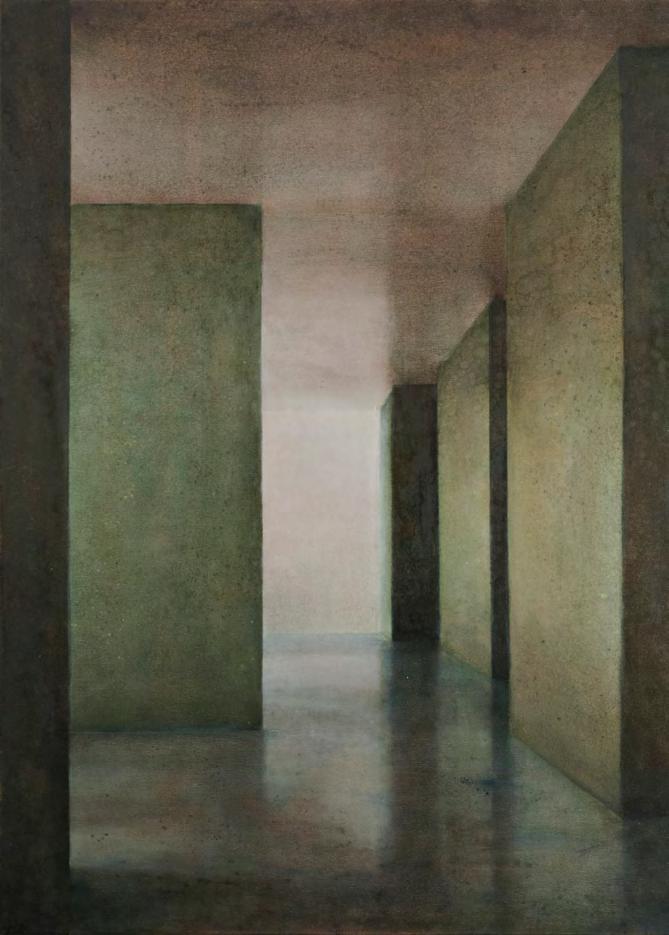
Julia Roberts is a landscape painter whose work is rooted in the forests of coastal New South Wales. From the angophoras of Bouddi National Park to the Spotted Gum and Burrawang forests of Murramarang, her paintings explore the quiet relationships, imagined conversations and subtle movements between trees. Through this intimate lens, Roberts invites viewers to reconsider their connection to the natural world and the silent presence of trees in the landscape.
Her practice celebrates both the beauty of the bush and the expressive possibilities of paint. Working primarily in acrylics and aerosol on primed plywood, Roberts draws from decades of sketchbook observations and a lifelong habit of daily drawing. Her surfaces are layered with colour, gesture and memory – each painting a meditation on place, presence and perception.
Roberts studied painting at the Chelsea School of Art in London and has exhibited widely in solo and group exhibitions across Australia, Singapore and the UK. Her studio at Macmasters Beach opens onto a terrace overlooking Bouddi National Park, where the trees she paints are her constant companions. Surrounded by music, radio and the rhythms of the bush, Roberts continues to explore the emotional and ecological resonance of the Australian landscape.


Alex Snellgrove celebrates the sensory and emotional connection that emerges from deep contemplation of landscape. Her paintings are inspired by nature’s quiet moments – shifting light, water and the subtle interplay between place and memory. Drawn especially to the ocean and its pools, Snellgrove explores the magnetic pull of water and the freedom it represents in Australian life.
Snellgrove’s process is intuitive and immersive, often sparked by a moment of visual resonance. She works with large brushes on wood, guided by memory and sensation rather than photographic accuracy. She is excited and challenged by painting, as it involves memory, senses, interpretation, discipline, making choices, energy and skill, and simply the fun of using paint. Her studio shifts with the light, from her home to a more expansive space in Blackheath.
Snellgrove has exhibited in solo and group shows, winning the Waverley Prize for Landscape (2014), the inaugural 9x5 Impressionism Prize (2016) and was a finalist in the Portia Geach Prize in 2021. She also teaches drawing and painting and is an active member of two sketch clubs.
www.alexsnellgrove.com.au

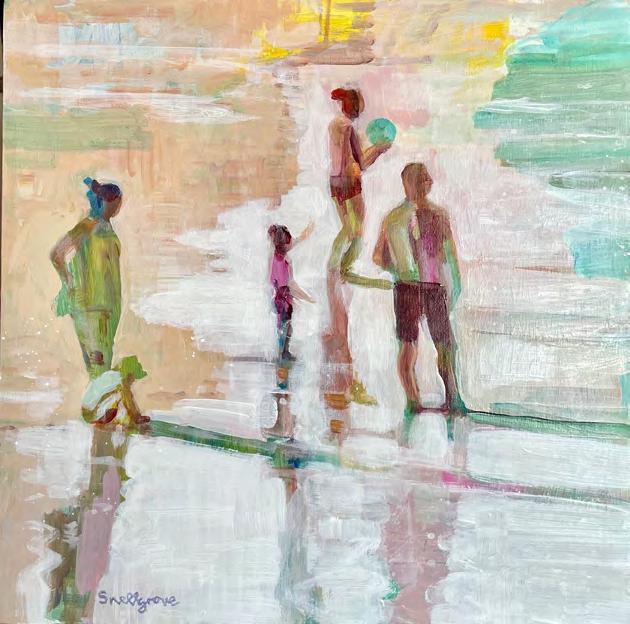
Sally Stokes is an abstract landscape painter whose work emerges from deep immersion in the natural world. Working between her bushland studio in Dural and a boatshed studio in a remote part of the Hawkesbury River, Stokes draws inspiration from the rugged terrain, shifting light and ancient angophoras that surround her. Her process begins with walking, observing, and drawing en plein air, using gouache, charcoal, and graphite to capture the essence of place. From these studies, she creates layered paintings in oil and acrylic that evolve through intuition, memory and imagination.
Stokes’ paintings are not direct representations but emotional responses –each one a journey shaped by impulse, reflection and the life of the painting itself.
With formal training in Fine Arts and Visual Arts, Stokes has exhibited widely, with 24 solo exhibitions and numerous group shows, and she was the winner of the Muswellbrook Art Prize, 2021. Her work is held in public collections including the Newcastle Art Gallery, Artbank, Muswellbrook Regional Arts Centre, and Hawkesbury Regional Gallery, as well as private collections in Australia and abroad.
www.sallystokes.com.au

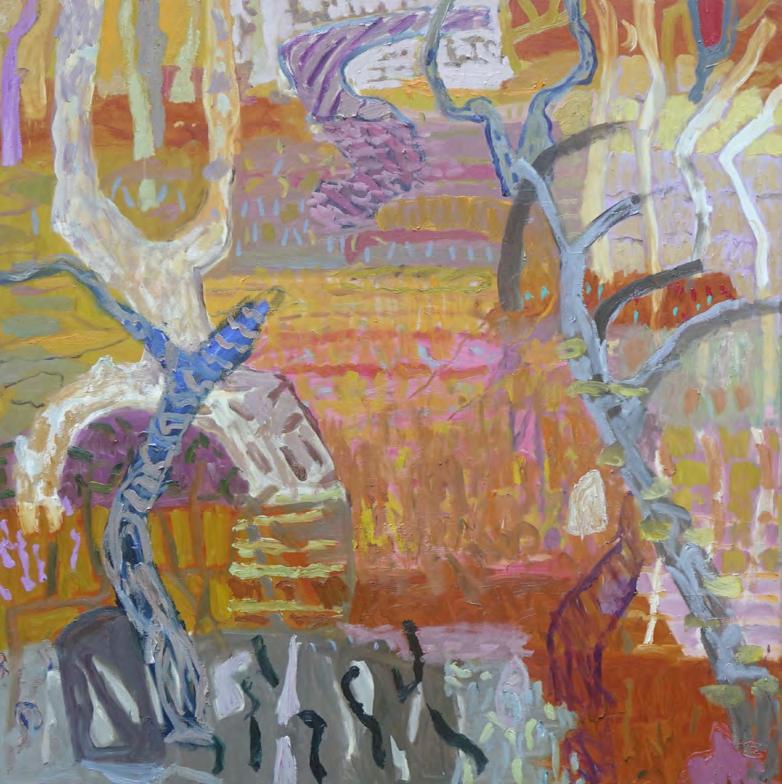
top: Sitting alone again, 2022, oil on linen, 152 x 152 cm
bottom: The temple of thought, 2022 oil on linen, 150 x 150 cm
Since 2014, the biennial Grace Cossington Smith art award has created an inspiring exhibition for Professional, Local and Emerging artists and for our Abbotsleigh students and community. We seek support and sponsorship for this award.
Gallery hours Tues to Sat 10 am-5 pm FREE ENTRY | Gate 7, 1666 Pacific Highway, Wahroonga | 02 9473 7878 | gcsgallery@abbotsleigh.nsw.edu.au | gcsgallery.com.au |
An Anglican Pre K–12 Day and Boarding School for Girls
We acknowledge and pay respect to the Dharug People of the Eora Nation as the Traditional custodians of the land upon which The Grace Cossington Smith Gallery rests. We recognise their continuous connection to culture, community and Country.